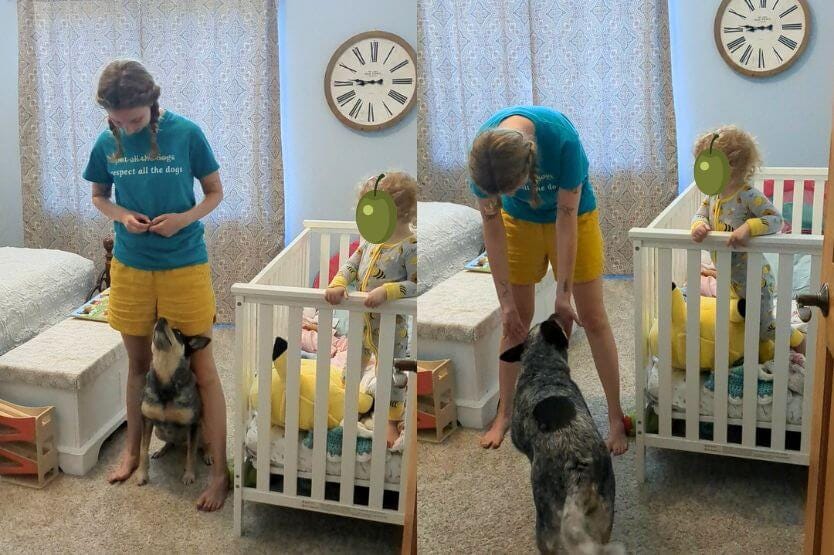On my niece's relationship with my sensitive cattle dog
My niece loves Scout. She’s just never touched her.
The first time my niece saw our heeler on this summer’s visit, she shouted “Auntie’s Scout!”
When I pointed to the ear tattoo on my inner wrist, she named it “Scout!” When I drew a mediocre cattle dog in sidewalk chalk, she cheered “Scout!”
When Scout chased a puller ring in the front yard she chirped “fast Scout”—then “all done Scout” when my dog disappeared around the corner. When I showed off a few of our heeler’s tricks, she started repeating our terminal reward marker (yes!) and the names of a few commands (touch, front). When Sean, Scout, and I aren’t at my parents’ house with everyone else, Olive still labels illustrations of dogs with pointy ears in her books as “Scout”.
My niece loves Scout. She’s just never touched her.
We often assume in order to meet a dog—in order to know a dog—we must directly interact with them. Scratch behind their ears. Pat their back. Snuggle on the couch. These are some of my favorite ways to spend time with my heeler. But they aren’t the only route to a relationship.
I meet new people all the time without exchanging physical contact. It would be absurd to say “we haven’t met” about someone I hang out with but do not hug. Even handshakes are gray area—I typically don’t extend my palm to friends of friends at casual campfires.
Olive will probably never pet Scout. I doubt the two will roam loose together (no matter my fantasies of toddler feet chasing paws around the yard and a curious snout licking chubby cheeks). It isn’t worth it. Scout is sensitive, easily startled, and quick to form negative associations. Olive is young, erratic, and quick to grab things she shouldn’t.
Despite my confidence in this particular risk assessment? Sometimes it does still feel weird. I mention in passing that Scout and Olive don’t interact… and catch the raise of a friend’s eyebrows. I gush about my niece to online connections… and field questions about why, if she’s become such a part of my life, Scout isn’t bigger in hers. And I internalize the assumptions.
In part, this discomfort reflects what I wanted as a kid. Small Haley felt deprived if I couldn’t pet the newest canine in my circle—no one ever presented me with alternatives—and thought it was “meet the dog by putting my hands on them” or “the dog is mean and life is unfair”.
Today I see the middle ground.
Olive is not harmed by not petting Scout. My niece misses out on one small thing—direct physical contact with my dog—to gain something more impactful: an understanding that animals have their own preferences. It’s good for her to know different creatures.
Scout does not want to be touched by most people other than me and Sean. She’s neutral, though, and content to lounge on the edge of the action. My family’s husky enjoys gentle pets so long as an adult guides Olive’s intensity. Therapy dog Margo is just thrilled to be involved, whatever that looks like. She’ll remove herself from a truly uncomfortable situation (oh, how we love to see the self advocacy!) but doesn’t mind if Olive milks her like a cow or trips over her fluttering tail with two-year-old clumsiness or lodges a sticky finger in her curls. She follows the small human around the house, actually, with the kind of intensity that helps me understand why some people refer to family pets as nannies.
I’m reminded of our fostering experiences. People asked when Scout would “meet” the puppies and I was never sure how to answer. As far as I was concerned, they had met. They spent time in the same room. They investigated each other’s scents. Scout knew about the baby dogs; the baby dogs knew about her. They weren’t friends, really. But they certainly weren’t enemies—or strangers—either.
All creatures can be happy and fulfilled and, yes, even together, without free interaction. Relationships are more than hugs and belly rubs.





